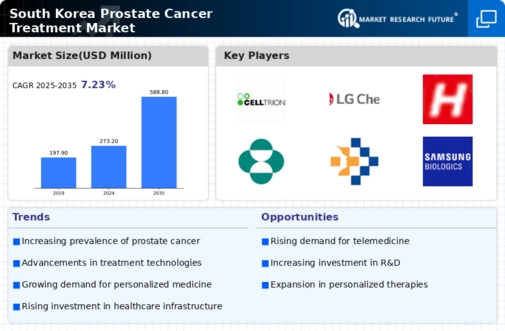The prostate cancer-treatment market in South Korea is characterized by a dynamic competitive landscape, driven by increasing incidence rates and advancements in therapeutic options. Key players such as Astellas Pharma (Japan), Bayer AG (Germany), and Johnson & Johnson (US) are strategically positioned to leverage innovation and partnerships to enhance their market presence. Astellas Pharma (Japan) focuses on developing novel therapies, particularly in the field of hormone therapy, while Bayer AG (Germany) emphasizes its commitment to research and development, particularly in precision medicine. Johnson & Johnson (US) adopts a multifaceted approach, integrating digital health solutions into its treatment protocols, thereby enhancing patient engagement and outcomes. Collectively, these strategies contribute to a competitive environment that prioritizes innovation and patient-centric solutions.
In terms of business tactics, companies are increasingly localizing manufacturing and optimizing supply chains to enhance efficiency and reduce costs. The market structure appears moderately fragmented, with several players vying for market share. However, the influence of major companies is substantial, as they drive trends in research, development, and distribution, shaping the overall competitive dynamics.
In October 2025, Bayer AG (Germany) announced a strategic partnership with a leading South Korean biotech firm to co-develop a new prostate cancer treatment. This collaboration is expected to leverage local expertise and accelerate the development timeline, indicating Bayer's commitment to enhancing its portfolio in the region. Such partnerships may not only bolster Bayer's market position but also reflect a broader trend of collaboration between multinational corporations and local firms to foster innovation.
In September 2025, Astellas Pharma (Japan) launched a new digital platform aimed at improving patient adherence to prostate cancer therapies. This initiative underscores Astellas' focus on integrating technology into treatment regimens, potentially leading to better patient outcomes and satisfaction. The strategic importance of this move lies in its alignment with the growing trend of digital health solutions, which are becoming increasingly vital in managing chronic conditions like cancer.
In November 2025, Johnson & Johnson (US) unveiled a new AI-driven diagnostic tool designed to enhance early detection of prostate cancer. This innovation not only positions Johnson & Johnson at the forefront of technological advancement in oncology but also reflects a significant shift towards data-driven decision-making in treatment protocols. The introduction of such tools may redefine competitive advantages in the market, emphasizing the role of technology in improving patient care.
As of November 2025, current trends in the prostate cancer-treatment market include a pronounced focus on digitalization, sustainability, and the integration of artificial intelligence. Strategic alliances are increasingly shaping the competitive landscape, as companies recognize the value of collaboration in driving innovation. Looking ahead, competitive differentiation is likely to evolve from traditional price-based strategies to a focus on technological innovation, supply chain reliability, and enhanced patient engagement. This shift suggests that companies that prioritize these aspects may gain a competitive edge in the rapidly evolving market.
























Leave a Comment